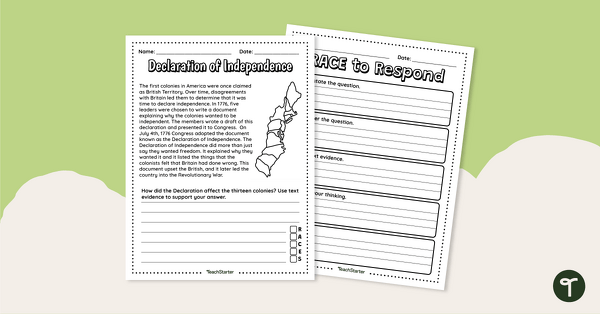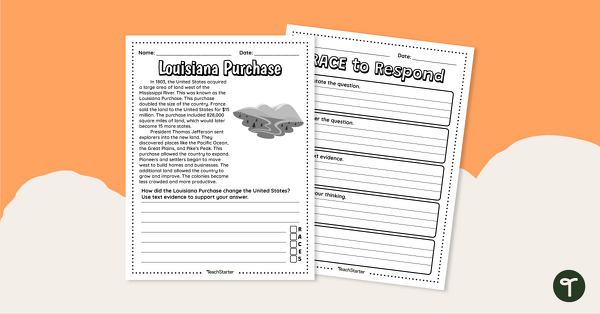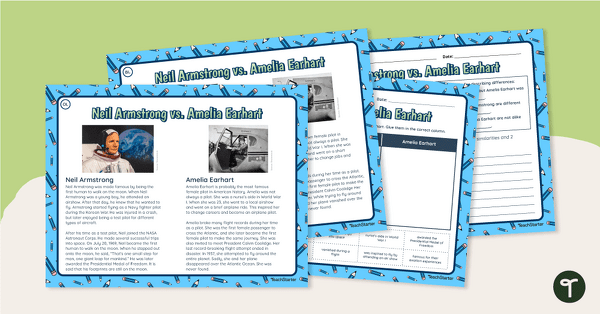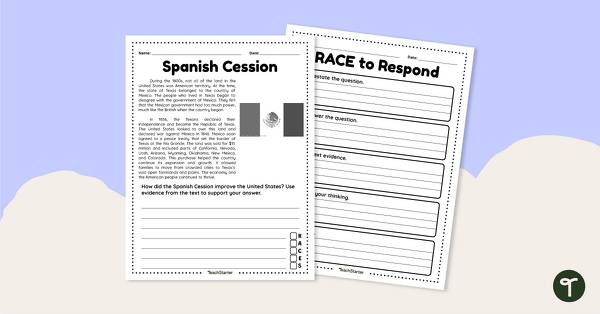Constructed Response Writing (RACES Writing) Teaching Resources
Making your own constructed response worksheets and questions to assess your students' understanding? Say hello to a teacher-created collection of constructed response worksheets in PDF and Google Slides form and hello to saving time on your lesson plans!
With both printable and digital options, this teacher resource collection is stocked with writing prompts, R.A.C.E.S. graphic organizers, and more tools you can use to assess your ELA students.
Curious about using constructed response in your classroom? Take a look at this quick guide from our teacher team, including a definition for constructed response and examples to use in your classroom.
What Is a Constructed Response?
Constructed responses are non-fiction reading and writing experiences connected to content in all subject areas and geared toward students in grades K-6. These writing opportunities are critical to assessing student understanding of nonfiction texts, and they are heavily weighted on standardized tests.
Including CRQs or constructed response questions is a crucial part of using this teacher tool. CRQs require students to construct an answer (hence the name) rather than choosing from a pre-filled list. This setup requires students to carefully read the question being posed and to use detailed explanations and/or relevant vocabulary to showcase their depth of understanding.
A constructed response can measure how students:
- Organize their thoughts
- Demonstrate higher-level thinking skills
- Provide support to explain their answers
5 Constructed Response Examples to Use in Your Classroom
Constructed response can take a variety of forms, and this collection is filled with countless examples that tie into different parts of the social studies curriculum. Explore them all for ready-made writing tasks for your students, or explore these ideas and examples from our teacher team!
- Evaluate the impact of a particular president on American society.
- Summarize the key events in a story, and explain their significance to the overall plot.
- Discuss the advantages and disadvantages of cellphones.
- Argue whether a particular character made the right decision and support your argument with evidence from the text.
- Compare and contrast the types of government found in the United States and Australia.
What Is the RACE for Constructed Responses?
Have you noticed our RACES writing activities and wondered what they're all about? Let's dive into this helpful strategy for elementary writers!
The RACE strategy is a framework for writing constructed responses that's built on an acronym for easy recall for your students.
RACE stands for:
- R — Restate the question
- A — Answer the question
- C — Cite evidence from the text
- E — Explain how the evidence supports your answer
RACES is another version of this same strategy, with an optional S in the acronym, which stands for summarize. Whether you include the fifth step or stop at 4, this mnemonic helps students organize their thoughts and ensure that they fully address the question.
Here is a brief overview of each RACES step:
- Restate the question — The first step tells students to begin writing their responses by restating the question in their own words. This helps ensure they fully understand the question and can focus their response accordingly.
- Answer the question — In step two, students are asked to provide a direct and concise answer to the question that has been asked. The goal is to make sure the answer is relevant to the question and addresses all parts of the prompt.
- Cite evidence from the text — In step 3, students use specific examples or evidence from the text to support their answer. This could include quotes, paraphrases or other specific details that help to illustrate their point.
- Explain how the evidence supports your answer — In step four (or the final step in the RACE strategy), students explain how the evidence cited supports the answer. This step demonstrates a student's understanding of the text and the question at hand.
- Summarize your main points — In a sentence or two designed to round out their response, students summarize the main points of their response. This helps ensure the response is well-organized and easy to follow and emphasizes the key points they've made. The goal is to leave a lasting impression on the reader.
- Plus Plan

Declaration of Independence- Constructed Response Passage Worksheet
Blend reading, writing, and historical concepts with the Declaration of Independence worksheet.
- Plus Plan

The Louisiana Purchase -Constructed Response Worksheet
Integrate reading, writing, and Social Studies content with a Louisiana Purchase Constructed Response worksheet and graphic organizer.
- Plus Plan

Armstrong vs. Earhart -Differentiated Paired Passage Worksheets
Combine reading and history content with differentiated reading comprehension worksheets.
- Plus Plan

Mexican Cession- Constructed Response Passage Worksheet
Teach your students how to write a good constructed response and integrate grade level Social studies concepts with a Mexican Cession-based Constructed Response worksheet and graphic organizer.